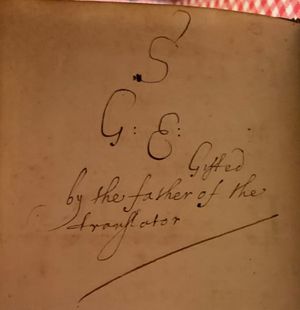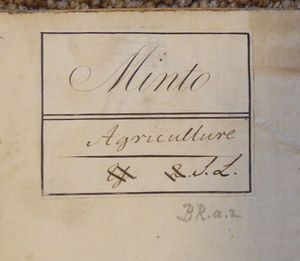Difference between revisions of "Gilbert Elliot ca.1693-1766"
| Line 17: | Line 17: | ||
A copy of Sir George Mackenzie's ''An Idea of the Modern Eloquence of the Bar'' (Edinburgh: Robert Freebairn, 1711) in the collection of Blackie House Library and Museum, Edinburgh, is inscribed with the baronet’s initials “S.G.E.,” as well as “S” and “P2” in an old hand(s) which may represent shelfmark(s). No other examples of this ownership inscription have been found. | A copy of Sir George Mackenzie's ''An Idea of the Modern Eloquence of the Bar'' (Edinburgh: Robert Freebairn, 1711) in the collection of Blackie House Library and Museum, Edinburgh, is inscribed with the baronet’s initials “S.G.E.,” as well as “S” and “P2” in an old hand(s) which may represent shelfmark(s). No other examples of this ownership inscription have been found. | ||
| − | Several of the books listed in the 1738 catalogue have been found in institutional and private collections bearing a later (ca. 1800-1815?) engraved Minto book label (Franks 20703). A number of these show evidence of one or more earlier handwritten shelfmarks below the | + | Several of the books listed in the 1738 catalogue have been found in institutional and private collections bearing a later (ca. 1800-1815?) engraved Minto book label (Franks 20703). A number of these show evidence of one or more earlier handwritten shelfmarks below the label — some with strike-through marks — which may have been associated with the eighteenth-century library. Some also have visible letters and/or numbers in an old hand which could also be related to this phase. One copy has “G Elliot” handwritten below the bookmark, but it is unclear whether this represents the second baronet. The few dozen copies inspected thus far show no evidence of annotations and are in various binding styles, several contemporary with the imprints. Research is ongoing. Please contact Meghan Constantinou, mrconstan@gmail.com. |
[[file:P1320071(1).JPG|thumb|The Minto book label, Franks 20703, with subject classification and shelfmarks, from a copy of ''De re rustica'', 1769, private collection]] | [[file:P1320071(1).JPG|thumb|The Minto book label, Franks 20703, with subject classification and shelfmarks, from a copy of ''De re rustica'', 1769, private collection]] | ||
| + | |||
====Sources==== | ====Sources==== | ||
<div id="sourcelist"> | <div id="sourcelist"> | ||
Latest revision as of 23:51, 20 January 2024
Sir Gilbert ELLIOT, 2nd baronet ca.1693-1766
Biographical Note
Son of Sir Gilbert Elliot (1650/51–1718), legal writer and Covenanter, who was created 1st Baronet of Minto in April 1700. In 1703, the first baronet purchased Minto House near Hawick, Roxburghshire, which served as the family seat until the mid-twentieth century. Sir Gilbert Elliot, 2nd Bart, enrolled at the University of Utrecht in 1712 to study civil law and was admitted advocate of the Scots bar in July 1715. He succeeded to the Minto estate and baronetcy in 1718 and served as MP of Roxburghshire in 1722-1726. In 1726, he was appointed to the bench in the Court of Session, adopting the legal title Lord Minto. From 1733 to 1763, he was a Lord of Justiciary, and in 1763, he was promoted to Lord Justice Clerk, which position he held until his death. He split most of his time between Minto House in Roxburghshire and his townhouse in Edinburgh, also called Minto House.
Elliot was a member of the Worthies Club, the Philosophical Society, the Edinburgh Musical Society, the Society in Scotland for the Propagation of Christian Knowledge, and the Society of Improvers in the Knowledge of Agriculture in Scotland. He was a shareholder in the British Linen Bank and the Royal Bank of Scotland. While serving on the bar, he was appointed to the committee responsible for the Faculty of Advocates library, and he was a subscriber to numerous contemporary publications. He almost certainly authored or co-authored (with his son, Sir Gilbert Elliot, 3rd Bart) the anonymous tract, Proposals for carrying on certain public works in the city of Edinburgh [Edinburgh, 1752].
Books
Elliot is credited with establishing the family library (Elliot, p. 311). A manuscript library catalogue entitled, A catalogue of books belonging to the hon[ora]ble Sir Gilbert Elliot of Minto Bart, one of the Senators of the Colledge of Justice (Edinburgh, 1738), is held by the Grolier Club of New York (call no. \*08.25\M667\1738\Folio). It is the earliest in a group of eight manuscript and typescript catalogues of the Minto library dating between 1738 and 1938, all held by the Grolier Club and bearing the bookplate of A.N.L. Munby. (They were probably acquired in the 1960s as part of an exchange between Munby and Grolier Club Librarian Gabriel Austin, but the documentation has not been found to confirm.) The catalogue lists approximately 1600 titles in approximately 2250 volumes, arranged alphabetically. The entries record author, title, size, place of publication, date, and number of volumes. The library was rich in legal texts, history, politics, classics, and belles lettres. Approximately 1500 titles date between 1600 and 1738, of which over half are later than 1701. Over a third of the books were printed in London; 84 were printed in Edinburgh, ranging in date between 1582 and 1737. The library contained mainly printed books, but a few contemporary manuscripts were also present.
In 1738, Minto House in Roxburghshire began undergoing a major renovation after a design by William Adam, which included the installation of a skied library. Since the library catalogue was produced in Edinburgh in the same year, it may have been made in connection with the upcoming move. Included with the catalogue is a hastily compiled manuscript inventory representing an earlier phase of the project, which includes the same titles organized by location into “the middle press below the stairs” and “Lord Minto’s drawing room below the stairs.”
The principal Elliot family library remained at Minto House until the mid-twentieth century, where it was added to by successive baronets and earls of Minto. An itemized typescript shelf inventory taken in 1938 listed over 12,000 volumes, including many titles from the 1738 catalogue (Grolier Club, \*08.26\M667\1938). Minto House was requisitioned during World War II and abandoned by the family either at that time or shortly before. Approximately 1500 volumes of books were sold at Sotheby’s on 22-24 January 1951 (lots 583-894), and the remainder were likely sold through the trade around the same time. An earlier sale in Edinburgh by Dowell on 22-25 March 1920 included seventy-four lots of books, watercolors, drawings, and engravings (lots 992-1065). After serving as the Craigmount girls’ boarding school from 1952 to 1966, Minto House was repurchased by the sixth earl of Minto in 1972 and demolished in 1992.
Characteristic Markings
A copy of Sir George Mackenzie's An Idea of the Modern Eloquence of the Bar (Edinburgh: Robert Freebairn, 1711) in the collection of Blackie House Library and Museum, Edinburgh, is inscribed with the baronet’s initials “S.G.E.,” as well as “S” and “P2” in an old hand(s) which may represent shelfmark(s). No other examples of this ownership inscription have been found.
Several of the books listed in the 1738 catalogue have been found in institutional and private collections bearing a later (ca. 1800-1815?) engraved Minto book label (Franks 20703). A number of these show evidence of one or more earlier handwritten shelfmarks below the label — some with strike-through marks — which may have been associated with the eighteenth-century library. Some also have visible letters and/or numbers in an old hand which could also be related to this phase. One copy has “G Elliot” handwritten below the bookmark, but it is unclear whether this represents the second baronet. The few dozen copies inspected thus far show no evidence of annotations and are in various binding styles, several contemporary with the imprints. Research is ongoing. Please contact Meghan Constantinou, mrconstan@gmail.com.
Sources
- Blackie, Jane. "Elliot, Sir Gilbert, second baronet, Lord Minto (bap. 1693, d. 1766), judge." Oxford Dictionary of National Biography.
- Elliot, George F.S., The Border Elliots and the Family of Minto. Edinburgh: David Douglas, 1897.
- Evans, John P., The Rise of the Elliots of Minto: A Scottish Family's Life in the Eighteenth Century. Amberley Publishing, 2017.
- Gambier Howe, E. R. J. Franks bequest: catalogue of British and American book plates bequeathed to the ... British Museum. London, 1903-4.
- Photos, drawings, and architectural plans of Minto House in various stages can be seen online at Canmore, the digital repository for Historic Environment Scotland.
- Information from Meghan Constantinou.

